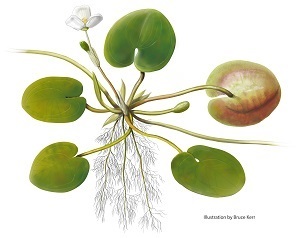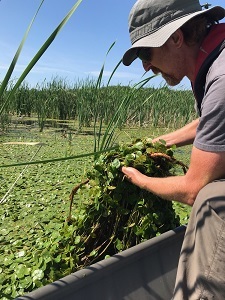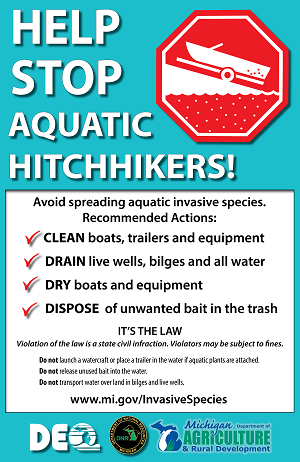|
Local leaders asked to help share information to slow the spread
European frog-bit, an invasive aquatic plant, has been found in the Dansville State Game Area (SGA) and the Waterloo Recreation Area (SRA). The Department of Environment, Great Lakes, and Energy (EGLE) confirmed the presence of European frog-bit in 2020 in an impoundment in the Dansville SGA and in Mud, Mills, Winnewanna and Green lakes in the Waterloo SRA.

“We are asking local leaders, including municipalities and environmental organizations, to help raise awareness about this invasive plant and what can be done to prevent its spread,” said Joanne Foreman, invasive species communications coordinator with the Department of Natural Resources.
European frog-bit was first detected in southeast Michigan in 1996 and has since spread along the coastal areas of lakes Erie and Huron up to the eastern Upper Peninsula.
In 2016, the plant, which resembles a miniature water lily with leaves about the size of a quarter, was discovered in Reeds and Fisk lakes in East Grand Rapids. It was found in several small bodies of water in Oakland County in 2018 and in the Lower Grand River in Ottawa County and Pentwater Lake in Oceana County in 2019.
|
The problem
European frog-bit can form dense mats on the surface of slow-moving waters like bayous, backwaters and wetlands. These mats can impede boat traffic and alter food and habitat for ducks and fish.
Because European frog-bit is free-floating, it can easily spread or be transported to new locations. European frog-bit also produces seed-like structures called turions that may remain dormant for multiple seasons. Human activities like boating, waterfowl hunting and fishing can unintentionally help spread the invasive plant because plant parts and turions can attach to boats, trailers and gear.
State game and recreation areas are popular destinations, which means there is a high potential to spread European frog-bit from these locations to other areas of Mid-Michigan and beyond.
Michigan's Invasive Species Program staff and partners plan and undertake survey and response efforts. Michigan’s Invasive Species Program is cooperatively implemented by the Department of Environment, Great Lakes, and Energy, the Department of Natural Resources, and the Department of Agriculture & Rural Development.

To date, EGLE staff has completed surveys of bodies of water in the Dansville SGA and Waterloo and Pinkney SRAs, as well as most lakes with public access in the area, finding no additional infestations.
All visible frog-bit plants were successfully removed by hand from Mills Lake, but due to heavy infestations, Mud, Green and Winnewanna lakes and the Dansville State Game Area impoundment require more intensive response options that cannot be completed in 2020.
Responding to infestations of this size requires a considerable amount of planning. Information gained in 2020 will be used to guide discussions with land managers for future on-the-ground efforts. Those discussions are planned for winter 2020 and into early 2021.
|
How you can help
The cooperation of local leaders like you is essential in helping to spread the word about European frog-bit. You can help by sharing information about European frog-bit in public meetings, with lake and community associations, and through your websites, newsletters and local news media.
The following information is designed to be shared with the public:
Reporting:
The Michigan Invasive Species Program encourages anyone who finds European frog-bit to report their discovery.
How to report new locations of European frog-bit:
- Any sightings of European frog-bit can be reported through the Midwest Invasive Species Information Network (MISIN) through the MISIN website, at MISIN.MSU.edu or by downloading the MISIN app to a smartphone.
- MISIN offers a short identification tutorial which helps distinguish between European frog-bit and similar aquatic plants.
- Reports also can be made to EGLE Aquatic Invasive Species Program by emailing EGLE-WRD-ANC@michigan.gov or calling 517-284-5593.
- If you encounter European frog-bit on the water, take some photos. These can be uploaded on the MISIN website, attached to a report via the MISIN app, or sent via email to EGLE.
Public education:
Preventing the spread of European frog-bit is essential to protect the ecosystems and recreation opportunities in Michigan. The best way to prevent further spread is to educate recreational users and riparian landowners about the issue and what they can do about it.
Key messages to share with the public:
- Invasive European frog-bit is harmful to the environment and can hinder recreational activities like boating, fishing and hunting.
- European frog-bit can be moved from one location to another when plant fragments or turions stick to boats, trailers or equipment.
- Clean, Drain & Dry boats, gear and equipment before going to another location.
- Learn how to identify and report European frog-bit.
Online resources:
Use these on websites, social media, or for distribution or presentation in meetings.
Print resources:
The following resources are available through the Michigan Department of Environment, Great Lakes, and Energy – contact Kevin Walters at Waltersk3@michigan.gov:
 |
|
Boat launch sign (16” x 24”)
- Sturdy, weather-resistant sign reminding boaters to clean, drain and dry boats and trailers and to dispose of bait in the trash.
- Place at all municipal boating access sites.
- Encourage private launch sites to install.
- Available at no cost while supplies last.
|
 |
|
Rack card (4" x 9" double-sided)
- This rack card describes new boating laws requiring boaters to remove all debris and aquatic plants from boats and trailers and to remove plugs and drain all water from bilges and live wells before transporting.
- Place or distribute rack cards at local offices, public places and any locations visited by boaters.
- Available at no cost while supplies last.
|
Law Enforcement:
Local law enforcement agencies and their marine divisions can help by providing education to boaters and waterfowl hunters regarding the need to clean, drain and dry their boats and trailers.
New boating laws, effective as of March 2019, are aimed at preventing the movement of aquatic invasive species like European frog-bit. It can be helpful to remind all boaters that they are responsible for the following prior to transporting any watercraft over land:
- Removing all drain plugs from bilges, ballast tanks, and live wells.
- Draining all water from any live wells and bilges.
- Ensuring that the watercraft, trailer, and any conveyance used to transport the watercraft or trailer are free of aquatic organisms, including plants.
This means that after trailering boats, and before getting on the road, boaters must pull plugs, drain water and remove plants and debris.
Violation of the law is a state civil infraction and violators may be subject to fines up to $100.
Read the full text of the Natural Resources and Environmental Protection Act (NREPA) – Act 451 of 1994, Part 413 (Section 324.41325).
Who to contact for more information:
William Keiper
Aquatic Biologist
Water Resources Division
Michigan Department of Environment, Great Lakes and Energy
517.342.4087 | keiperw@michigan.gov
Michigan's Invasive Species Program is cooperatively implemented by the Department of Environment, Great Lakes, and Energy, the Department of Natural Resources, and the Department of Agriculture & Rural Development.
Photos:
Click on the links for high-resolution photos for use in press, social media or websites. Captions follow.
European frog-bit plant: European frog-bit resembles small water lilies, with white, three-petaled flowers visible between June and August.
Turions: Turions are seed-like structures that can spread European frog-bit when they attach to boats and gear.
European frog-bit illustration: European frog-bit is a free-floating aquatic plant with small (0.5 to 2.5-inch) leaves. Illustration courtesy of Bruce Kerr.
Removal: EGLE Aquatic Biologist Tom Alwin removes European frog-bit from a backwater area in Pentwater River State Game Area.
Dansville: Dense mats of European frog-bit were found in an impoundment at the Dansville State Game Area.
|